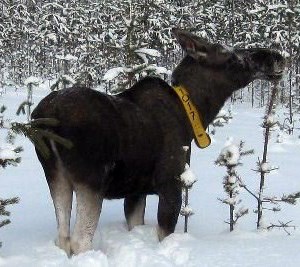Moose telemetry data from Wireless Remote Animal Monitoring (WRAM) is now available in the Analysis Portal for biodiversity data.
Wireless Remote Animal Monitoring (WRAM) is an e-infrastructure for biotelemetry data automatically collected by different sensors. The infrastructure is hosted by UC-WRAM at SLU in Umeå.
WRAM handles biotelemetry data from fish and wildlife, e.g. moose, bear, wolf and salmon. Sensor measurements ranging from positions (GPS), acceleration, proximity and heart rate to body temperature and internal sensors are stored in the database.
UC-WRAM and Swedish LifeWatch have been cooperating for several years. A web service harvesting WRAM data to Swedish LifeWatch is now up and running and WRAM data is included in the Analysis portal.
Due to the huge amount of data available from each individual in the WRAM database, LifeWatch harvests only aggregated position data from WRAM. Initially UC-WRAM provides data on moose (Alces alces) from different projects with GPS-collared moose in Sweden. During the initial phase, data from in total 596 individuals covering a total time period between 2003 and 2015 is publically available.
Aggregated data
When harvested by LifeWatch, the raw spatial data (GPS positions) in the WRAM Data Warehouse are aggregated per individual at the level of one month into an monthly 'observation'. The aggregated 'observation' reported in the Analysis Portal is based on the midpoint of maximum and minimum latitude and longitude for the animal and month in question. The 'coordinateUncertaintyInMeters' value is calculated as the distance in meters between the midpoint and the maximum latitude and longitude position.
In other words: the minimum and maximum latitude and longitude for each individual and month form a rectangular box with the reported 'observation' as center point. The 'uncertainty' is then just the distance between the center point and the upper right corner of the box (max lat & lon in our hemisphere).
